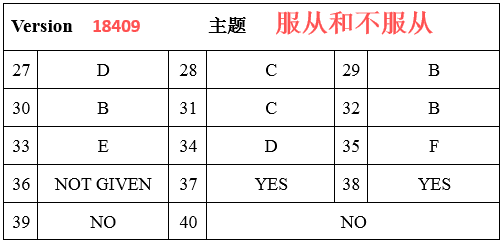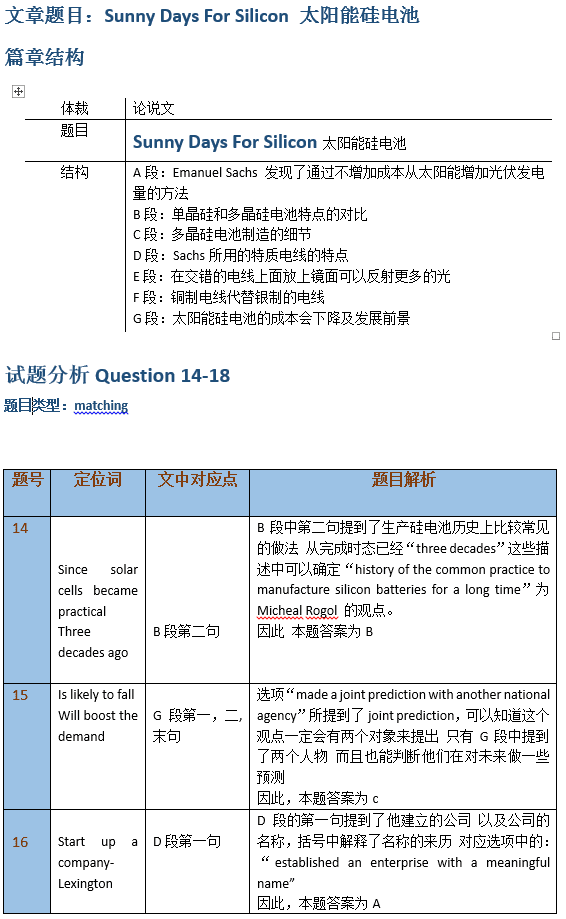托福阅读作为托福考试中的一部分,托福阅读有没有技巧?回答是有。但是托福阅读中,技巧是一种辅助工具,最重要的是努力勤奋。下面小编就和大家分享托福阅读满分修炼记,来欣赏一下吧。
托福阅读满分修炼记
托福阅读理解满分的出现必须依赖于3个方面的训练:
1.托福词汇
从某种意义上来讲,词汇量的大小是TOEFL阅读理解高分的基础和关键。如果词汇量没有达到基本要求(五千以上),纵然你有"葵花宝典"在手,也只能命丧ETS的“毒招”之下。所以,以牺牲词汇量为代价的技巧练习简直是一味巨毒无比的“五毒散”。
2.托福阅读技巧
TOEFL的阅读量非常大,一般的中国考生根本无法把文章全部读完,所谓的“扫读法”、“跳读法”和“略读法”也只能适用于少数类型的文章,根本不能解决本质问题。那么,文章到底应该怎么读法呢?一句话,主动地阅读文章的关键部位。所谓主动是指不能象一般的阅读那样完全被动地接受信息,而应该不断的进行思考和预测;所谓关键部位,主要是每一段的开头和结尾部分。由于TOEFL的阅读理解文章全部选自于正式出版物,文章的逻辑结构非常完整和严谨,而且出现的逻辑模式也是屈指可数。经过系统的训练,考生的预测可以做到非常准确的程度。这样,通过阅读文章的几处关键部位,就能很快地把握整个文章的结构和内在的逻辑关系,也就解决了问题的70%。
3.托福解题训练
排除法恐怕是一直以来大多数学生在解阅读理题目时使用最多的方法。事实上,这种方法具有致命的缺点:干扰大、费时间。更有效和迅速的办法是读完题干之后,就在脑子反映出一个模糊的或者是不完整的答案,然后直接在选项中寻找接近的答案进行判断。这种能力必须在平时的训练和讲解中逐渐养成和加强,决非什么技巧之类的东西可以替代。
除了上述三方面的训练之外,如果能够对一些基本的背景知识加以补充的话,更能确保阅读理解的准确率和速度。所以托福阅读的真正提高并不是去学习一些技巧,而是在训练中养成一种无意识的使用技巧的习惯,做到实力与技巧巧妙的结合。
托福阅读背景素材之虚拟现实法治疗抑郁症
阿凡达疗法,是科学家受阿凡达的“化身”技术启发,将虚拟现实用在抑郁症治疗上的一种新型技术。技术的关键是让患者把一个虚拟的自己当成自己的“化身”,让虚拟成人安慰自己,从而摆脱抑郁症的困扰。
Patients wore a virtual reality headset to see fromthe perspective of a life-size 'avatar' or virtual body. Seeing this virtual body in a mirror moving in thesame way as their own body typically produces theillusion that this is their own body. This is called'embodiment'.
患者头戴一个虚拟现实头盔后, 可看到一个与自己大小一样并动作同步的虚拟形象,会把这个形象看做自己的“化身”,以他/她的视角来看待外物。
While embodied in an adult avatar, participants were trained to express compassiontowards a distressed virtual child.
在“化身”为成人阿凡达后,。研究人员让患者通过这个“化身”安慰一个虚拟出来的悲伤男孩,
As they talked to the child it appeared to gradually stop crying and respond positively tothe compassion.
在患者与这名男孩交谈后,男孩逐渐不再哭泣,对安慰作出积极回应。
After a few minutes the patients were embodied in the virtual child and saw the adultavatar deliver their own compassionate words and gestures to them.
几分钟后,研究人员让患者把这个虚拟男孩当做自己的“化身”,让虚拟成人安慰虚拟男孩。
This brief eight-minute scenario was repeated three times at weekly intervals, and patientswere followed up a month later. Of the 15 participants, nine reported reduced depressivesymptoms a month after the therapy.
这个过程持续8分钟,每星期重复3次。一个月后,9名患者症状减轻,其中4名显著减轻。
Virtual reality has also previously been used to treat psychological disorders includingphobias and post-traumatic stress disorder, but this research focused on a new applicationfor promoting emotional well-being.
虚拟现实技术此前已被用于治疗多种心理障碍,如恐惧症、创伤后应激障碍等,但此次研究聚焦于改善患者心理健康这一新领域。
托福阅读真题原题+题目
Archaeological literature is rich in descriptions of pot making. Unlike modern industrial potters, prehistoric artisans created each of their pieces individually, using the simplest technology but demonstrating remarkable skill in making and adorning their vessels.
The clay used in prehistoric pot making was invariably selected with the utmost care: often it was traded over considerable distances. The consistency of the clay was crucial: it was pounded meticulously and mixed with water to make it entirely even in texture. By careful kneading, the potter removed the air bubbles and made the clay as plastic as possible, allowing it to be molded into shape as the pot was built up, When a pot is fired, it loses its water and can crack, so the potter added a temper to the clay, a substance that helped reduce shrinkage and cracking.
Since surface finishes provided a pleasing appearance and also improved the durability in day-to-day use, the potter smoothed the exterior surface of the pot with wet hands. Often a wet clay solution, known as a slip, was applied to the smooth surface. Brightly colored slips were often used and formed painted decorations on the vessel. In later times. Glazes came into use in some areas. A glaze is a form of slip that turns to a glasslike finish during high-temperature firing. When a slip was not applied, the vessel was allowed to dry slowly until the external surface was almost like leather in texture. It was then rubbed with a round stone or similar object to give it a shiny, hard surface. Some pots were adorned with incised or stamped decorations.
Most early pottery was then fired over open hearths. The vessels were covered with fast-burning wood; as it burned, the ashes would all around the pots and bake them evenly over a few hours. Far higher temperatures were attained in special ovens, known as kilns, which would not only bake the clay and remove its plasticity, but also dissolve carbons and iron compounds. Kilns were also used for glazing, when two firings were needed. Once fired, the pots were allowed to cool slowly, and small cracks were repaired before they were ready for use.
1. What does the passage mainly discuss?
(A) Why archaeologists study prehistoric pot making
(B) How early pottery was made and decorated
(C) The development of kilns used by early potters
(D) The variety of decorations on Prehistoric pottery
2. The word meticulously in line 7 is closest in meaning to
(A) heavily
(B) initially
(C) carefully
(D) completely
3. Which of the following was a process used by prehistoric potters to improve the texture of the clay?
(A) adding temper
(B) removing the water
(C) beating on the clay
(D) mixing the clay with plastic substances
4. The word durability in line 13 is closest in meaning to
(A) quality
(B) endurance
(C) adaptability
(D) applicability
5. Prehistoric potters applied slips and glazes to their vessels in order to do which of the
following?
(A) Improve the appearance of the vessels
(B) prevent the vessels from leaking
(C) Help the vessels to dry more quickly
(D) Give the vessels a leather like quality
6. Which of the following was a method used by some potters to give vessels a glassy finish?
(A) Smoothing them with wet hands
(B) Mixing the clay with colored solutions
(C) Baking them at a very high temperature
(D) Rubbing them with a smooth hard object
7. The word incised in line 20 is closest in meaning to
(A) designed
(B) carved
(C) detailed
(D) painted
8. The word they in ling 27 refers to
(A) kilns
(B) firings
(C) pots
(D) cracks
9. According to the passage , the advantage of kilns over open fires was that the kilns
(A) required less wood for burning
(B) reached higher temperatures
(C) kept ashes away from the pots
(D) baked vessels without cracking them
10. Look at the terms temper (line 10), glazes (line 16), kilns (line 24), and compounds (line 25).
Which of these terms is NOT defined in the passage ?
(A) temper
(B) glazes
(C) kilns
(D) compounds
11. The passage mentions that when pottery is fired under burning wood, the ashes help
(A) prevent the clay from cracking
(B) produce a more consistently baked pot
(C) attain a very high temperature
(D) give the vessel a glasslike finish
PASSAGE 49 BCCBA DBCBD B
托福相关文章:
★ 学习资料库
★ 海棠无香
★ SAT考题又重复 中国学生接下来该怎么办
★ 英语口语3000句第一课(1-94)
★ 2020托福听力5大出题规律是什么
★ 2020托福听力要提分的要求有哪些
★ 美好的校园时光
★ “天气热”的十大英语表达
★ 推免三分钟自我介绍范文5篇
★ 学习资料库
托福阅读满分修炼记
上一篇:新托福阅读之基础理解和篇章应用
下一篇:返回列表






